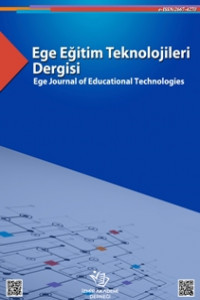Çizge Algoritmaları için Bir Mobil Öğrenme Uygulaması
Bu çalışmada, üniversitelerde Ayrık Yapılar derslerinde işlenen çizge teorisi kapsamındaki çizge algoritmalarının öğetimini desteklemek için geliştirilen bir mobil öğrenme uygulaması sunulmaktadır. Geliştirilen mobil uygulama; öğrencilerin çizgeleri oluşturmalarını, var olan çizgeleri yeniden biçimlendirmelerini ve bu çizgeler üzerinde temel çizge algoritmalarını çalıştırmalarını sağlayan bileşenler içermektedir. Bu bağlamda, kullanıcılar oluşturdukları yönsüz/yönlü, ağırlıksız/ağırlıklı çizgeler üzerinde DFS (Depth First Search - Derinlik Öncelikli Arama), BFS (Breadth First Search - Genişlik Öncelikli Arama), Dijkstra’nın En Kısa Yol Bulma, Euler Yol/Devre (Path/Circuit), Hamilton Yol/Devre (Path/Circuit) ve Çizge Renklendirme (Graph Coloring) algoritmalarını çalıştırabilmektedir. Ayrıca, öğrenciler bilgi düzeylerini sınamak amacıyla mini sınavlar olabilmektedir. Geliştirilen mobil öğrenme uygulaması, Ege Üniversitesi Bilgisayar Mühendisliği Bölümü'nde verilen Ayrık Yapılar dersi kapsamında gönüllü öğrenciler tarafından kullanılarak test edilmiştir. Öğrenciler mobil öğrenme uygulamasının lab çalışmaları için faydalı olduğunu belirtmiş ve ilerleyen yıllarda tamamlayıcı bir araç olarak kullanılmasını önermiştir. Bunun yanı sıra, önerilen mobil öğrenme uygulamasının kullanımının, test gubundaki öğrencilerin notlarına olan olumlu katkısı istatistiksel olarak ispatlanmıştır.
Anahtar Kelimeler:
Çizge teorisi, çizge algoritmaları, mobil öğrenme, ayrık yapılar
A Mobile Learning Application for Graph Algorithms
In this paper, a mobile learning application developed to support teaching graph algorithms as part of the graph theory topics in discrete mathematics courses at universities is presented. The mobile application includes components that enable students to draw graphs, edit previously formed graphs and apply basic graph theory algorithms on these graphs. In this context, the users can apply DFS (Depth First Search), BFS (Breadth First Search), Dijkstra’s Shortest Path, Euler Path/Circuit, Hamilton Path/Circuit and Graph Coloring algorithms on the undirected/directed, unweighted/weighted graphs they have formed. Additionally, students can take quizzes to test their knowledge level. The mobile learning application has been tested by voluntary students as a part of the Discrete Mathematics course in Ege University, Department of Computer Engineering. The students stated that the mobile learning application is useful for lab works and suggested it to be used as a complementary tool in the following years. Besides, the positive effect of the usage of the proposed mobile learning application on the grades of the students in the test group has been proven statistically.
Keywords:
Graph theory, graph algorithms, mobile learning, discrete structures,
___
- Bitincka, L., & Antoniou, G. E. (2004). PDA‐based Boolean Function Simplification: a Useful Educational Tool. Informatica, 15(3), 329-336.
- Çiloğlugil, B. (2006). Mobil çizge öğrenme sistemi gerçekleştirimi (Yüksek Lisans Tezi, Ege Üniversitesi).
- Inceoglu, M. (2005). A discrete mathematics package for computer science and engineering students. Computational Science and Its Applications–ICCSA 2005, 538-546.
- Inceoglu, M. M., Ciloglugil, B., & Karabulut, K. (2007). MOGRAPH: Mobile Graph Algorithms Library for Engineering Students. International Journal of Engineering Education, 23(3), 499-507.
- Jan, S. R., Ullah, F., Ali, H., & Khan, F. (2016). Enhanced and Effective Learning through Mobile Learning an Insight into Students Perception of Mobile Learning at University Level. International Journal of Scientific Research in Science, Engineering and Technology (IJSRSET), Print ISSN, 2395-1990.
- Johnsonbaugh, R. (1997). Discrete mathematics. Prentice-Hall, 4th ed, New York.
- Kukulska‐Hulme, A. (2013). Mobile‐Assisted Language Learning. The encyclopedia of applied linguistics.
- Kruse, R., & Tondo, C. L. (2007). Data structures and program design in C. Pearson Education India.
- Lafore, R., & Waite, M. (2003). Data structures & algorithms in Java (pp. 251-313). Sams.
- Lee, K. W., & Lee, J. H. (2005, May). Design and implementation of mobile-learning system for environment education. In International Conference on Computational Science and Its Applications (pp. 856-862). Springer Berlin Heidelberg.
- Martin, F., & Ertzberger, J. (2013). Here and now mobile learning: An experimental study on the use of mobile technology. Computers & Education, 68, 76-85.
- Rosen, K. H. (1995). Discrete Mathematics and its Applications. Higher Education. 4th edition. McGraw-Hill.
- Sharples, M., Taylor, J., & Vavoula, G. (2010). A theory of learning for the mobile age. In Medienbildung in neuen Kulturräumen (pp. 87-99). VS Verlag für Sozialwissenschaften.
- Seppälä, P., & Alamäki, H. (2003). Mobile learning in teacher training. Journal of computer assisted learning, 19(3), 330-335.
- Vavoula, G., & Karagiannidis, C. (2005). Designing mobile learning experiences. Advances in informatics, 534-544.
- Walton, G., Childs, S., & Blenkinsopp, E. (2005). Using mobile technologies to give health students access to learning resources in the UK community setting. Health Information & Libraries Journal, 22(s2), 51-65.
- Yayın Aralığı: Yıllık
- Yayıncı: İzmir Akademi Derneği
